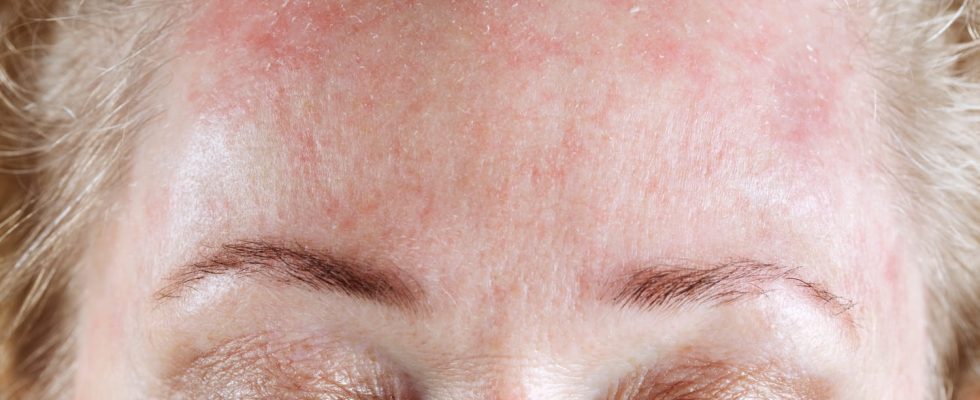Seborrheic dermatitis is a common inflammation that causes redness and flaking, especially on the skin of the face, beard, hair. Photo and list of symptoms, causes, treatment…
Seborrheic dermatitis is an inflammatory skin disease that occurs mainly at the level of the face, the folds of the nose, the beard or the scalp (hair) of the baby or the adult. How do you know if you have seborrheic dermatitis? What symptoms? How do you get dermatitis? Can seborrheic dermatitis be cured? How to get rid of seborrheic dermatitis? Naturally? With medication? A shampoo ?
What is seborrheic dermatitis?
The term “dermatitis” (or “dermatitis”, the two terms are synonymous) means inflammation of the skin. Seborrheic dermatitis is inflammation of the skin in so-called “seborrheic” areas, that is to say in skin areas that produce a lot of sebum due to a large number of sebaceous glands.
Seborrheic dermatitis on the face, beard…
Seborrheic areas (those that produce a lot of sebum) are mainly located on the face :
- forehead (between the eyebrows),
- the folds around the wings of the nose (nasolabial folds)
- scalp
- chin skin when wearing a beard.
Photo of a face with seborrheic dermatitis
“Seborrheic dermatitis is a phenomenon at the limit of the normal“, explains Dr. Pierre Vabres, dermatologist. “We incriminate the proliferation of a yeast that we all have on the surface of the skin as adults: Malassezia“There are different types of Malassezia. When it proliferates excessively, it can cause seborrheic dermatitis.”We don’t know exactly whether the cause is the yeast itself or whether it is the body’s reaction to the yeast“, specifies Dr. Vabres. Certain deficiencies which are found in particular in alcoholics due to malabsorption may also be involved.
What are the symptoms of seborrheic dermatitis?
Seborrheic dermatitis is mainly manifested by:
- redness in seborrheic areas
- desquamation (the skin is peeling) or dandruff if the dermatitis is localized on the scalp
- itches.
Treatment involves decreasing yeast overgrowth by using antifungal treatments. “That corresponds azole products and in particular ketoconazole“specifies Dr. Vabres. They exist in the form of foaming gels. Low-dose topical corticosteroids and prescribed over a short period of time can help fight against the inflammatory reaction.
What shampoos to treat seborrheic dermatitis on the hair?
When seborrheic dermatitis affects the scalp, it causes dandruff and itching. “We use ketoconazole or another imidazole product to stop yeast overgrowth“explains Dr. Vabres. Low-dose topical corticosteroids may also be prescribed to you for short periods of time.
This hairy area may also be affected by seborrheic dermatitis. “The best would be to shave the beard“advises Dr. Vabres. Failing that, imidazole foaming gels and topical corticosteroids may be prescribed.
What are the natural remedies for seborrheic dermatitis?
“The idea is above all to respect the physiology of the skin“explains Dr. Vabres. That is to say that it is necessary to respect the pH of the skin and not to use surfactants and products that are too alkaline. as the Marseille’s soap.
What are the foods to avoid?
“There are no foods to avoid“explains Dr. Vabres: adopt a balanced diet to prevent possible deficiencies is probably the best nutritional recommendation for the prevention or treatment of seborrheic dermatitis.
Seborrheic dermatitis in infants
Seborrheic dermatitis in infants corresponds to what is commonly called “milk crusts”. The cause is essentially the same as in adults with an overgrowth of yeast: the infant becomes contaminated in the first days of its life through contact with adults. It affects the scalp, the folds of the neck as well as the seat.
“We traditionally use I’sweet almond oil to loosen the scales“explains Dr. Vabres. Ketoconazole may be prescribed in the most severe, resistant or persistent cases. “He Avoid products containingsalicylic acid which are dangerous for the infant” finally warns Dr Vabres.
Thanks to Dr Pierre Vabres, dermatologist.
